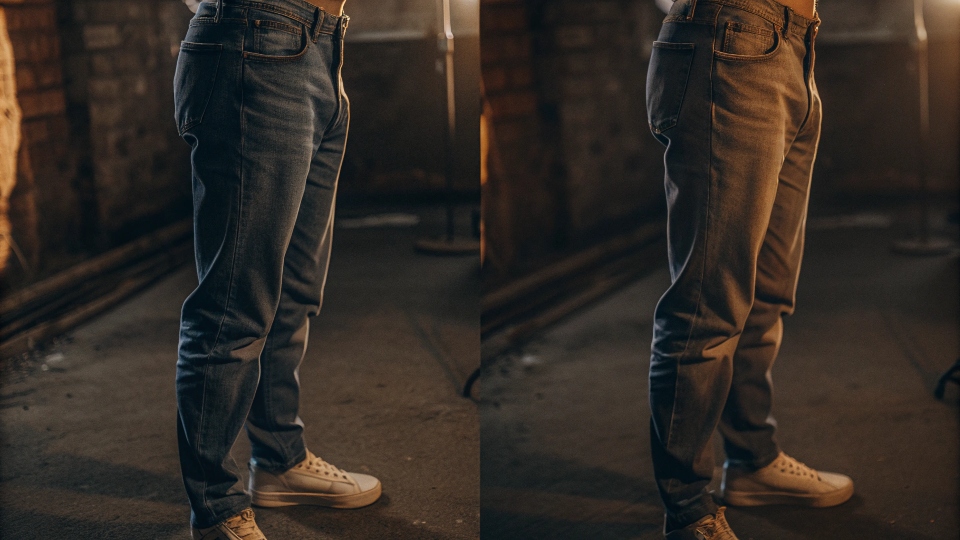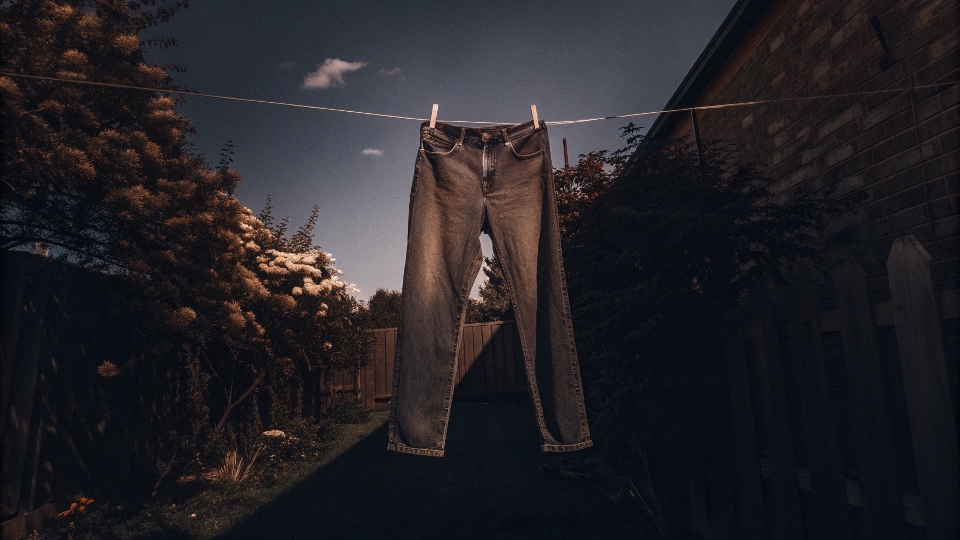You love the comfort of baggy jeans1, but the sloppy silhouette ruins your look. You feel frumpy instead of stylish. What if you could get a sharper fit without sacrificing comfort?
To make baggy jeans less baggy, use a hot wash2 and high-heat dry for minor shrinking. For a more tailored result, sew a tapering seam along the inner leg, or add darts to the waistband to cinch it in.
In my 20 years running the DiZNEW denim factory, I've learned that fit is everything. A designer I highly respect, Dean, believes that a garment's success hinges on its silhouette. Many people think fixing baggy jeans is about complex tailoring, but often it's much simpler.
Your insight about starting with the right size is the most important rule. A baggy style should still fit you perfectly at the waist. But if you already have a pair that's too big, don't worry. I'll walk you through the same principles we use in the industry to adjust the fit, from simple tricks to easy sewing techniques.
How to shrink jeans that are too baggy?
You bought a pair of 100% cotton jeans3 hoping they would shrink to the perfect size. After a few washes, they're still too loose, leaving you swimming in denim. You need a reliable way to shrink them down.
The most effective method to shrink 100% cotton jeans is to wash them on the longest cycle with the hottest water possible, then immediately tumble dry them on the highest heat setting. This process can shrink them by up to one full size.
This method is a bit of a blunt instrument, but it's powerful. At the factory, we call this a "hot soak," and it's used to pre-shrink raw denim. The magic lies in how cotton fibers react to heat and moisture.
When cotton gets wet, the fibers absorb water and swell. Then, the intense heat from the dryer causes them to constrict and tighten up significantly as they dry.
The Hot Wash Method: A Step-by-Step Guide
Be aware this method shrinks the jeans everywhere, including the length, so it's best for jeans that are too big all over.
- Preparation: Turn your jeans inside out. This helps protect the color from fading too much during the aggressive wash cycle.
- The Wash: Place the jeans in the washing machine alone. Set the machine to the hottest water setting and the longest, most heavy-duty wash cycle. Do not add any detergent.
- The Dry: As soon as the wash cycle is finished, immediately transfer the jeans to the dryer. Use the highest heat setting available and let them run until they are completely bone-dry. The combination of a hot wash followed by a hot dry provides the maximum shrinking power. Check the fit. If you need more shrinkage, you can repeat the process.
How to soften baggy jeans?
Your baggy jeans are not only too big, but they're also stiff and rigid. The coarse fabric doesn't drape well, making them feel even bulkier and more unflattering. You want them to feel soft and comfortable.
To soften baggy jeans, wash them with one cup of white vinegar instead of detergent. Then, tumble dry them on low heat with a few wool dryer balls or clean tennis balls to physically beat the fabric into softness.
New jeans are often stiff because of "sizing," a starch-like finish applied at the factory to make the fabric easier to handle during sewing. Your goal is to break down this finish and loosen the cotton fibers.
The common mistake is to use liquid fabric softener, which I never recommend. It just coats the denim fibers with a waxy film that can prevent them from breathing and softening naturally over time.
Instead, the vinegar wash is a brilliant trick. The acetic acid in the vinegar gently strips away the factory sizing4 and any mineral buildup from your water without harming the fabric. After the vinegar wash, the mechanical action in the dryer is key.
As the jeans tumble, the dryer balls continuously pound against the fabric. This action is like a tenderizer for denim; it breaks down the stiff fibers on a micro-level, leaving the jeans feeling significantly softer and more pliable.
This improved softness also helps the baggy jeans drape better on your body, which can itself reduce the appearance of excessive bulk.
How to reduce the size of baggy pants?
The hot water trick wasn't enough, and your jeans are still too wide in the legs. You're ready to make a permanent alteration but don't want to pay for a professional tailor.
The best way to permanently reduce the size of baggy pants is to taper them. Turn them inside out, pin the excess fabric along the inseam, and sew a new, straight line from the knee down to the ankle.
This is the most direct way to get a slimmer fit, and it's the technique tailors use most often. It's much easier than it sounds. You are essentially creating a new, thinner pant leg inside the old one.
Tapering Your Jeans at Home
- Pin for Fit: Turn your jeans inside out and put them on. Stand in front of a mirror and pinch the excess fabric along the inner seam (the inseam) of one leg. Use safety pins to hold the fabric where you want your new seam to be. Start at the knee and pin down to the ankle. You want a smooth, straight line.
- Mark the Line: Take the jeans off carefully. Lay the pinned leg flat and use a ruler and tailor's chalk to draw a straight line along your pins. This will be your sewing guide.
- Sew the Seam: Using a sewing machine with a denim needle and strong thread, sew directly on top of the chalk line you drew. Backstitch at the beginning and end to lock the seam.
- Finish and Repeat: Try the jeans on again to check the fit. If you're happy, you can trim the excess fabric about half an inch from your new seam. Now, measure the amount you took in and repeat the exact same process on the other leg for a symmetrical result.
How to stop jeans from going baggy?
You have a pair of jeans that fits perfectly when you first put them on. But after just a few hours of wear, the seat gets saggy and the knees get stretched out and baggy.
To stop jeans from going baggy, choose a pair with 1-2% Lycra or elastane for better shape retention. Also, wash them infrequently in cold water and always hang them to air dry5, as high heat from a dryer can permanently damage these stretch fibers.
This is where your insight is absolutely critical. Preventing bagginess is much easier than fixing it, and it starts the moment you buy the jeans. From my two decades of experience, here are the non-negotiable rules.
It Starts with the Right Foundation
First, buy the correct size. Even a "baggy fit" style should fit your waist perfectly without a belt. If the waist is too big, the whole garment will slide down and look sloppy.
Your point about boxer shorts is also excellent; bulky underwear can create lumps and ruin the line of your pants. A good belt and a tucked-in shirt provide structure and create a much more polished look, instantly counteracting a "baggy" appearance.
Fabric is Everything
| Understanding the fabric is key. | Fabric Type | Tendency to Bag | How it Wears |
|---|---|---|---|
| 100% Cotton | High | Stretches with wear and stays stretched out until washed. | |
| Stretch Denim (1-2% Elastane) | Low | Stretches for comfort but "snaps back" to its original shape. |
If you hate when jeans get saggy throughout the day, a quality stretch denim6 is your best friend.
Proper Care for Longevity
Finally, how you care for your jeans matters immensely. High heat is the enemy of elasticity. A hot dryer will cook the elastane fibers, causing them to become brittle and lose their ability to snap back. Always wash your jeans in cold water to preserve the fibers and color, and hang them to dry. This single habit will dramatically extend the life of your jeans' fit.
Conclusion
To make jeans less baggy, shrink them with hot water, taper them with a simple seam, or prevent the problem by buying the right size and washing them cold. Your perfect fit is achievable.
-
Explore expert styling tips to elevate your baggy jeans look and avoid a frumpy silhouette. ↩
-
Learn about the science behind hot washing denim and how it can help achieve the perfect fit. ↩
-
Understand the properties of 100% cotton jeans and how they behave after washing. ↩
-
Learn about factory sizing and how it affects the initial feel of new jeans. ↩
-
Learn why air drying is essential for maintaining the fit and longevity of your jeans. ↩
-
Understand the benefits of stretch denim and how it can enhance comfort and fit. ↩










